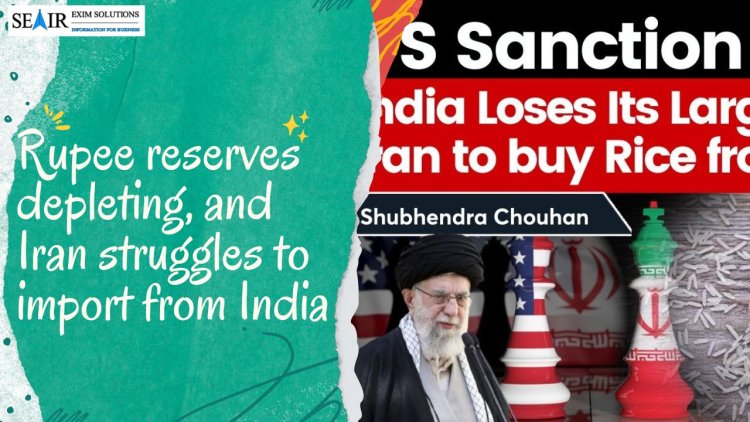Rupee reserves depleting, and Iran struggles to import from India
The rupee reserves of India, the country's foreign currency holdings, have been depleting, and this has had an impact on Iran's ability to import goods from India. Rupee reserves are crucial for a country's economic stability as they help support international trade and manage the exchange rate. When reserves decline, it becomes challenging to meet the demands of importing nations.
Share this Post to earn Money ( Upto ₹100 per 1000 Views )

The problem has also affected the export of other goods to Iran, including pharmaceuticals and tea. Following Iran's recent depletion of its currency reserves, people with knowledge of the situation said on Wednesday that India may lose Iran as one of its top customers for basmati rice exports.
According to the sources, the problem has also affected the export of other goods, like pharmaceuticals and tea, to Iran. Prior to New Delhi ceasing to purchase Iranian crude in the middle of 2019 as a result of US sanctions on Tehran, Iran had been paying for imports using rupee reserves amassed from oil shipments to India. Let’s explore the notification in detail:
Iran's Rupee Reserves Depleted, Impacting Trade with India
In 2022–2023, Iran purchased about a million tonnes of aromatic rice from India, accounting for 20.35 percent of the nation's 4.5 million tonnes of total basmati exports. Under the condition of anonymity, two people claimed that trade between Iran and India has significantly decreased during 2019–20 after New Delhi ceased purchasing Iranian crude in May 2019.
Along with Saudi Arabia and Iraq, Iran was one of the three main energy suppliers to the nation up until that point. One person observed, "It appears Iran has used up all of its rupee reserves, making trade in the local currencies of the respective countries impossible."
A second individual, who was knowledgeable about the management of India's currency, stated: "As far as I know, there may not be any trade in local currencies (rupee-rial trade)." In multiple recent meetings, the Iranian side brought up the problem with the Indian side and offered to begin oil shipments as a measure to increase rupee reserves held by India, the people added.
The Iranian side also cited India's decision to buy Russian crude in the face of Western sanctions and said that New Delhi should follow suit in order to resume buying Iranian energy, the sources continued.
According to government statistics, Iran has been either the greatest or second-largest importer of Indian basmati since 2014–15. In the years 2017–18, 2018–19, 2019–2020, and 2021–22, it was the main importer of the goods.
Iran bought 935,567 metric tonnes of basmati in 2014–15, and 1.4 million metric tonnes at its highest point in 2018–19. It was 998,879 metric tonnes for 2022–2023. In 2022–2023, Iran was the fourth-largest importer of Indian tea, with $68 million in purchases.
India's commerce with Iran decreased significantly in 2019–20 compared to the prior fiscal year, according to India Import Data. Compared to $13.53 billion in 2018–19, imports—which primarily consisted of Iranian crude—fell by approximately 90% to $1.4 billion.
India's exports to Iran decreased year over year, albeit not significantly (less than 5%), coming in at $3.37 billion in 2019–20 as opposed to $3.51 billion in FY19 as per Import export data. Nearly a tenth of its total imports for 2018–19, or 23.5 million tonnes, came from India and were purchased on favourable terms like a 60–day credit and other discounts.
In addition to crude, India principally bought from Iran petroleum products, intermediaries for dyeing fabrics, fruits, and predominantly exported basmati rice.
After India stopped importing petroleum, the trade balance, which had previously favoured Iran until May 2019, gradually changed to India's advantage. India exported commodities worth $1.66 billion in 2022–2023 (mostly basmati rice), whereas only $672 million in Iranian items were imported by India.
Based on India Import export Data, India's exports of products totaled $123 million in the first month of the current fiscal year (April 2023), an increase of 1.06% year over year; meanwhile, imports fell by 7.24% to $69 million.
Conclusion
The depletion of India's rupee reserves and Iran's struggle to import from India are having a negative impact on both countries' economies. India is losing out on potential trade revenue, and Iran is facing shortages of essential goods. The US sanctions are making it difficult for both countries to do business, and they are likely to continue to do so until the sanctions are lifted.
In addition to the US sanctions, there are other factors that have contributed to the depletion of India's rupee reserves and Iran's struggle to import from India. These include the COVID-19 pandemic, which has disrupted global trade, and the war in Ukraine, which has caused energy prices to rise. However, US sanctions are the main factor that has led to the current situation. However, if you need any type of guidance related to India Import Data or Import export data, connect to the Seair Exim Solutions platform to locate the global trade data at your doorstep. Book a free live demo today.






